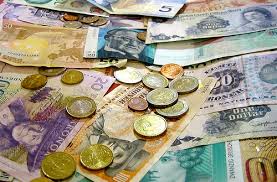This section will explain about the commodity and how their relationship with the commodity currencies.
What is a commodity currency?
In the world of Forex, there are currency, known as commodity currencies, the currencies of countries that are eksportis raw materials or commodities (such as precious metals, oil, agriculture, etc.). Many countries that fit the description above but the most traded are the New Zealand Dollar, Australian Dollar and Canadian Dollar. Therefore, known by the name of the commodity dollars or "Comdolls".
How commodities affect commodity currency?
In the financial world, gold is seen as a safe haven against inflation and also the most heavily traded commodity. For some people, such as trading the Australian dollar gold trading. Australia is the world's largest gold producer and 50% of exports are commodities, including precious metals.
This commodity represents a large portion of Australia's GDP; many traders see the rise and decline of commodity prices, especially gold, which can affect the Australian dollar. Some traders consider the movement of gold as a measure to predict the movements of the AUD / USD.
For countries producing large quantities of raw materials, the increase of commodity prices allows the country's currency price also rises and vice versa. Below is a commodity currency and how its movement is correlated with a particular commodity.
Canadian Dollar (CAD) and Oil ?
Oil is the lifeblood of the industrialized world and therefore in these conditions, the oil is a commodity traded and observable. Many countries that produce oil in excessive amounts, including Canada, which is one of the world's largest oil producer and has the second largest oil reserves after Saudi Arabia. Canada is also the largest supplier to the biggest oil consumer the United States. Because oil is one of the greatest needs in the industrial United States, raising the price of oil tends to give a bad influence on the U.S. equities and U.S. dollar, in turn will increase the income for Canada.
Oil is the lifeblood of the industrialized world and therefore in these conditions, the oil is a commodity traded and observable. Many countries that produce oil in excessive amounts, including Canada, which is one of the world's largest oil producer and has the second largest oil reserves after Saudi Arabia. Canada is also the largest supplier to the biggest oil consumer the United States. Because oil is one of the greatest needs in the industrial United States, raising the price of oil tends to give a bad influence on the U.S. equities and U.S. dollar, in turn will increase the income for Canada.
INCREASE oil prices tend to benefit Canada or harm the United States.
DECREASE in oil prices tend to be detrimental to Canada or the United States profitable.
If the trend of rising oil, the USD / CAD tends to have a trending down, and vice versa.
In the financial world, gold is seen as a safe haven against inflation and also the most heavily traded commodity. For some people, such as trading the Australian dollar gold trading. Australia is the world's largest gold producer and 50% of exports are commodities, including precious metals.
This commodity represents a large portion of Australia's GDP; many traders see the rise and decline of commodity prices, especially gold, which can affect the Australian dollar. Some traders consider the movement of gold as a measure to predict the movements of the AUD / USD.
INCREASE the price of gold tends to benefit Australia.DECREASE gold prices tend to be detrimental to Australia.
Like neighboring Australia, New Zealand's economy is also driven by commodity exports. Most traders do not compare the "Kiwi" with a particular commodity, but the state of commodities markets globally. So rise and fall of commodity prices as a whole, can give NZD movement / USD due to the dependency of New Zealand on their commodity exports.
Summary
Short term movements in commodity prices usually do not directly affect the currency. Analyzing the relationship with the commodity currencies is better suited for long-term outlook (long term). Although we saw no correlation between the commodity currencies and commodity prices alone, the export is only one part of the economy of a country. We must always look at the country's overall economy, interest rates and political situation. Combining all these aspects will produce a clearer picture and add a better idea of trading on the currency.
Summary
Short term movements in commodity prices usually do not directly affect the currency. Analyzing the relationship with the commodity currencies is better suited for long-term outlook (long term). Although we saw no correlation between the commodity currencies and commodity prices alone, the export is only one part of the economy of a country. We must always look at the country's overall economy, interest rates and political situation. Combining all these aspects will produce a clearer picture and add a better idea of trading on the currency.
















0 komentar
Post a Comment